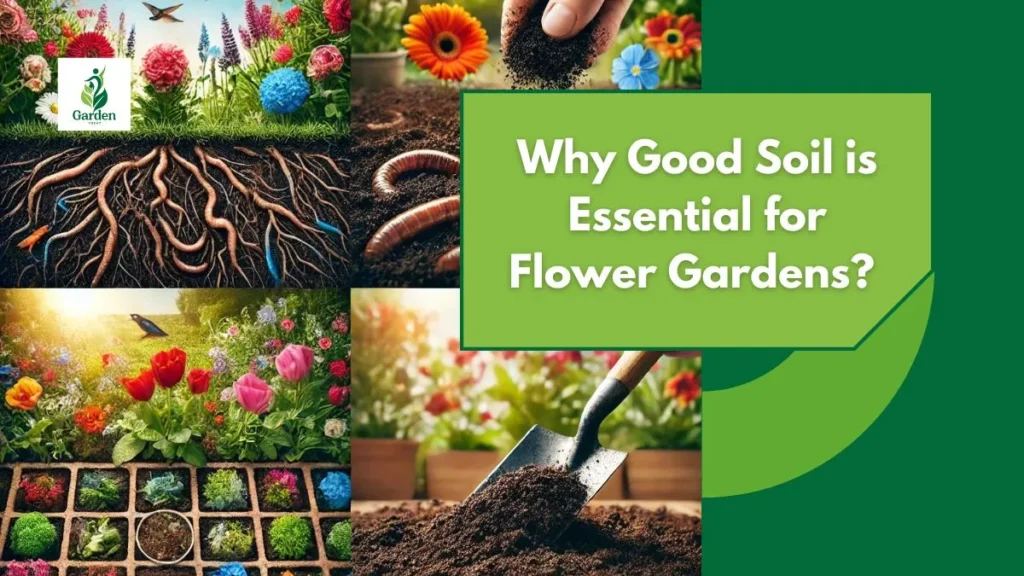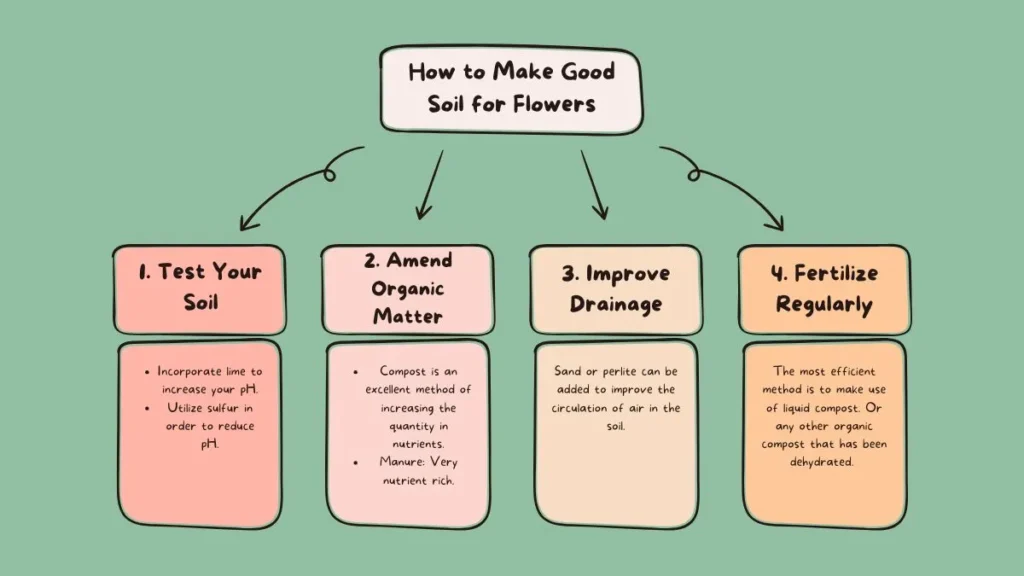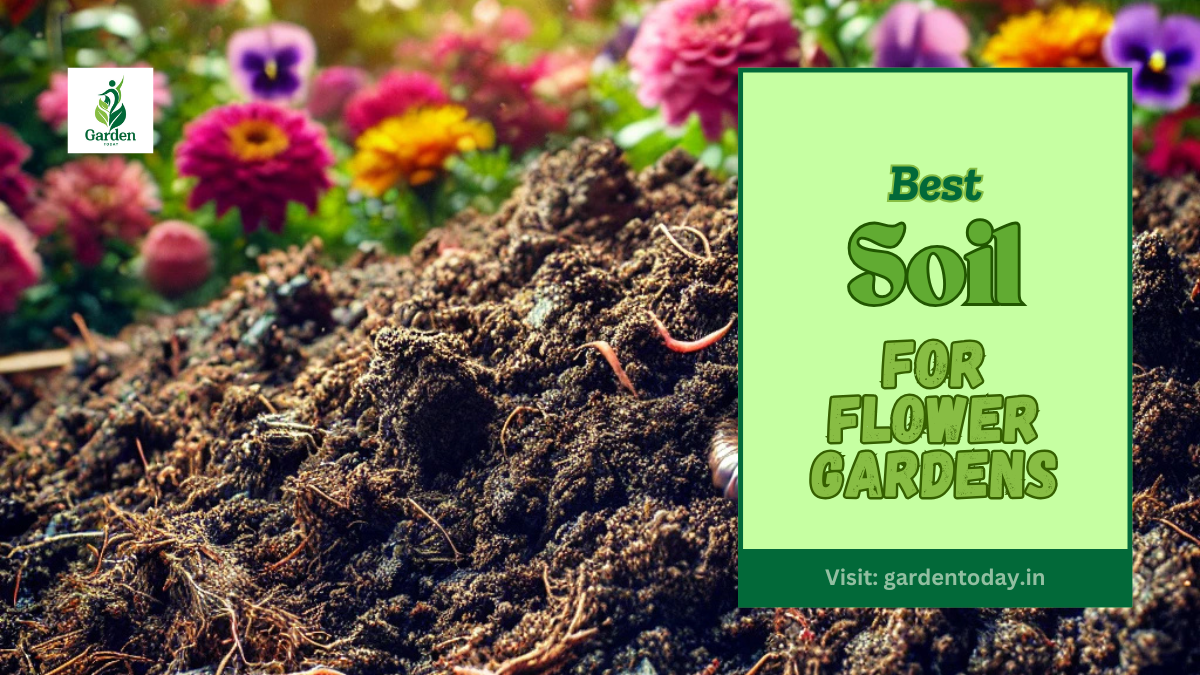The soil determines the kind of flowers can be grown by a person. grow. If you would like to grow flowers within flower beds that are raised as well as in ground gardens or even in containers, the right kind of soil must be selected. This guide lists the different kinds of soils as well as the conditions suggested by experts to help ensure the development in flowers.
Why Good Soil is Essential for Flower Gardens?

It is crucial to have a healthy soil to produce flowering plants. The ideal soil must be well-drained, full of nutrients soft and fluffy, retains moisture, but not overly so, and have an acidity that is in the right range.
- Well-Draining is one type of soil that protects root decay due to excessive moisture.
- It is rich in nutrients It provides minerals such as nitrogen, potassium and Phosphorus.
- The soft and light texture allows roots to spread easily.
- Balance Moisture-Helps plants to thrive between the waterings.
- The pH balance level ideal pH of soil should range somewhere between 6.0 to 7.0.
Best Soil for Different Types of Flower Gardens
1. Best Soil for Flower Beds
Ideal for flower Beds The mix of different soil types is essential to create flower beds so that flowers thrive.
- 50% Topsoil: Provides structure and minerals.
- 30% Compost: Adds organic matter and nutrients.
- 20% Perlite or Sand: Improves drainage and aeration.
This makes for nutrient-rich, well-draining soil that is perfect to grow flowers.
2. Ideal Soil for Container Flowers
If you plan to plant flowers in containers, it is important to use soil that is well-drained and light. is vital. For the best results, you should select one of the following types of soil:
- It is suggested to use potting soils as they are more suitable due to the fact that gardening soil is heavy and prone to compacting.
- Perlite or Vermiculite Both aid in aeration of the soil.
- Peat Cocoa Coir and Moss can retain moisture, but they aren’t saturated.
3. Ideal Potting Soil for Container Flowers
The potted flower requires premium potting mix recommended for the flowers. Make sure to examine on the mix’s components:
- Organic Matter Compost Peat moss, peat moss, along with the old tree bark.
- Perlite also known as Vermiculite aids in drainage and helps prevent compaction in the soil.
- Slow-Release Fertilizer assists in providing nutrients over the long-term.
To find the highest potable soils of the highest quality look into FoxFarm, Espoma and Black Gold.
Best Flowers for Different Soil Types
4. Good Flowers for Sandy Soil
This soil drains quickly and is lacking on nutrition. The most suitable flowers for this soil include:
- Lavender
- Black-eyed susan
- Blanket Flower
- Californian Poppy
- Coreopsis
To help aid in the maintenance of sandy soil organic peatmoss, compost, and mulch may be used to increase the fertility of soil and retain water.
5. Optimal Flowers to Grow in Clay Soil
Certain flowers thrive in environments that other plants may be unable to tolerate. This is because clay soil’s capacity to hold in excess water, and it is also able to compact easily. clay soil isn’t ideal to be used for garden. Some flowers that thrive in clay soil include:
- Daylillies
- Coneflowers
- Asters
- Black-Eyed Susan
- Bee Balm
To improve the accessibility of clay soil to construction, it’s possible to add perlite, sand and compost. This allows it to be used by an various species of plants.
6. Perennial Flowers to Grow in Clay Soil
The wintry plant is likely to bloom for extended periods, which means they are able to be used to beautify open areas three times per year, and are component of a cohesive clay soil. They are adaptable to clay soils
- Russian Sage
- Yarrow
- Hostas
- Sedum
- Liatris
How to Make Good Soil for Flowers

Modifying your soil to make sure it’s suitable for flowering is a diy project that anyone can do. Here are some tips on how you can improve your soil
1. Test Your Soil
Examine the soil that is already in use testing kit for soil to test. If there aren’t any nutrients available, you can add nutrients to the soil:
- Incorporate lime to increase your pH.
- Utilize sulfur in order to reduce pH.
2. Amend Organic Matter
- Compost is an excellent method of increasing the quantity in nutrients.
- Peat Moss (also known as Coconut Coir is a great way to hold moisture.
- Manure: Very nutrient rich.
3. Improve Drainage
Sand or perlite can be added to improve the circulation of air in the soil. Also, elevating the flower beds above surface may improve the conditions for growth if the soil is flooded with water.
4. Fertilize Regularly
The most efficient method is to make use of liquid compost. Or any other organic compost that has been dehydrated. The majority of flowers thrive when they are fed the best fertilizer that is balanced 10-10-10. Spread the fertilizer all across.
Maintenance Tips for Healthy Flower Soil

1. Adding Mulch
Mulching assists in balancing temperatures, moisture and protects the soil from erosion, prevents the growth of weeds and improves the soil layer. dirt. Some of the suggested materials are:
- Wood chips
- Straws
- Bark mulch
2. Crop Rotation
Don’t plant similar flowering plants in similar areas for more than one calendar year in order to prevent depletion of nutrition and the spread of diseases.
3. Management of Water
- Flowers bloom in the morning hours or during the evening hours.
- Don’t overwater. The majority of flowers like soil that is moist rather than soil that is wet.
4. Controlling Soil Testing
It is recommended to check the soil’s pH as well as nutrients twice per year to ensure adequate nutrition.
Conclusion
Soil that is ideal for flower gardens can be determined by the kind of flowers that will be planted and the climate within the zone. Containers or flower beds, as well as challenging soils like sand and clay soils may cause variations in the proper blend of soil. Controlling and improving the structure of your soil fertility, fertility, and drainage could aid in helping the ecosystem to promote the most healthful blooming.
A well-drained and properly controlled soil with a high fertility produces beautiful and healthy flowers all season. Start by choosing the type of soil that needs nitrogen and Castle Compost using organic matter. Then, choose the flower that is best for the conditions of the soil. By establishing the proper design your garden will flourish and provide a bounty of beautiful blooms each year.
Visit Garden Today

Thanks for your great idea